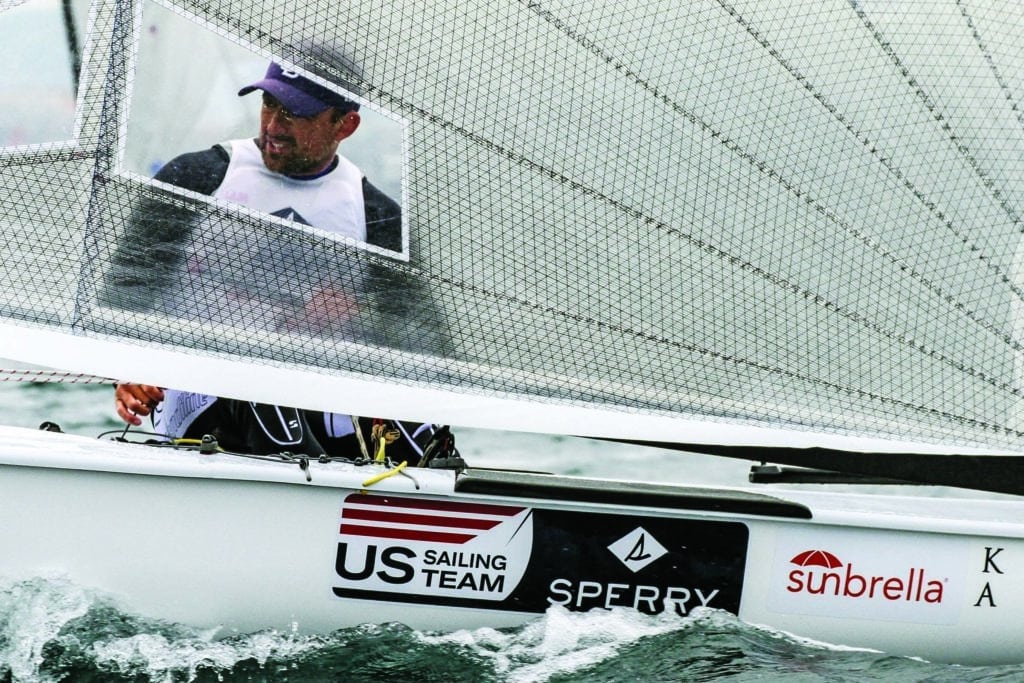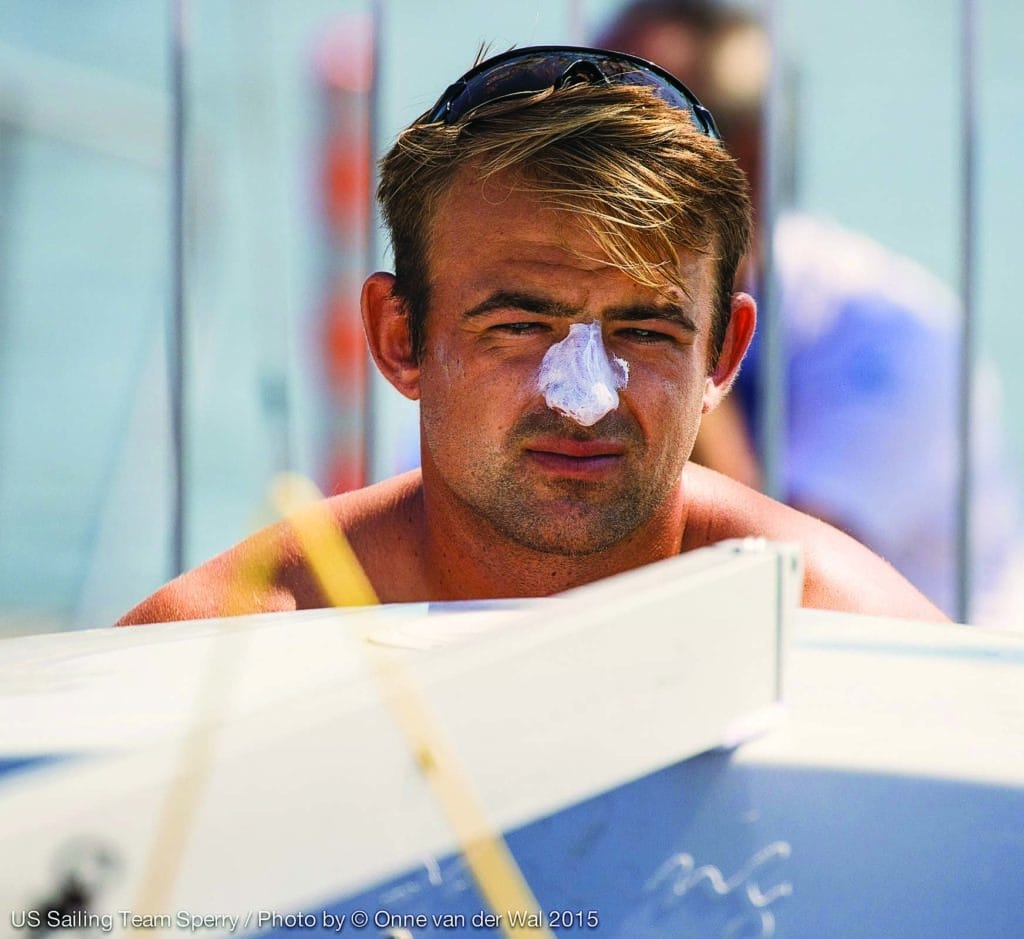
In the sixth race of the 2016 Finn European Championship, Caleb Paine rounded the weather mark close astern of Zach Railey, the last remaining obstacle on Paine’s six-year march to Rio. All he had to do was stay close on the last two legs to take a 10-point lead into the final races. On the line was the sole American Finn berth, and in the escalating pressure of the moment, doubt crept into Paine’s psyche: Was he good enough? The race result itself didn’t matter because neither of them was doing particularly well in the regatta. Where they stood relative to each other in the final results was what counted. Paine was sailing for his first Olympic appearance, and Railey, the 2008 Finn silver medalist, was back in the men’s singlehanded dinghy following a three-year hiatus. His campaign was less than a year old, but he’d beat Paine in the first event of the US Sailing Team’s two-regatta selection process. Only one point separated the two on the selection tally sheet. The stage had been set for an absorbing battle of skill, wit and nerves.
Railey had executed a perfect start at the pin end of the line and led Paine by more than 20 places at the weather mark. He was firmly in charge of the race, but Paine chipped away at the deficit on the second upwind leg, cutting Railey’s lead in half. Umpires then flagged Railey for a kinetics violation after the weather mark, and by the time he’d completed the required penalty turns, he was squarely in Paine’s crosshairs. What remained of the veteran Olympian’s lead then vanished on the run, and the two drew even as they approached the leeward mark. When it appeared time for Paine to strike, he was instead complacent, and Railey seized the opportunity and struck at him like a snake, jibing across the course and setting a mark trap, preventing him from passing.
Railey knew that if he could drag Paine deep into the fleet, he could end the day ahead on points, so he expertly blocked Paine from rounding the mark, long enough to allow 50 competitors to sail past. Paine tried several times to escape, and even fouled Railey a few times in the process. After completing penalty turns, he eventually found a way through, finishing 64th with Railey in 65th. Railey’s ploy had worked. Paine desperately hoped for another race to avenge himself, but the fleet was sent ashore for the day. The wind forecast for the following day wasn’t encouraging. With no races, the results would stand in Railey’s favor.
Ashore, Paine was surprisingly calm, which surprised him, and he kept his composure while filing a number of protests against Railey. Spending time in the protest room is the last thing a sailor wants after a race, least of all when your Olympic future depends on the outcome, but that is where the two sailors sat. After lengthy deliberations, the jury ruled against Railey for infringing Rule 18.4, commenting that neither sailor had a complete grasp of the rule. The net result was that the relative standings of both sailors remained, with Railey entering the final day with a 10-point lead.
Armchair pundits vilified Railey for his ruthless actions, but Paine would later say there were no hard feelings. Had the situation been reversed, he would have done the same: “I would absolutely try and do everything that’s within the rules. The fundamentals of what Zach did are fine.”
Paine dwelled upon it that evening, however, knowing he was one race away from either going home empty-handed or pulling his ticket to Rio. It was a late night because of the protest. “I was thinking about everything that had happened,” he says. “I can’t view this sport as a career. It’s a passion; it’s something I love to do. So I was OK with all the experiences I’ve had, all the hard work, and the lessons I’ve learned and the places I’ve traveled and the people I’ve met. It was all worth it regardless of whether I was going to the Olympics.”
He says he came to terms with it, but he wasn’t about to relent when they returned to the racecourse. “The sport of sailing is what it is,” he says. “There are so many variables out there, and it’s so unpredictable. It could have easily not swung my way, and that would have been tough. I don’t know how I would have dealt with that, but luckily I don’t have to.”

Fortune shined on Paine in the crucial final race of the series. After close-quarters prestart maneuvering, the two American contenders sailed away in opposite directions. Railey got stuck on the left side of the racecourse as the wind lessened, finishing midfleet. Paine sailed well to finish seventh and secured the U.S. selection.
He was nervous before they went sailing, he later admitted, but once on the water, he remained focused. “It’s not emotional,” he says. “You just make decisions based on what’s in front of you.” Once ashore, Railey approached Paine straightaway, shook his hand firmly, and said, “Good work, buddy.” He then hoisted his sailing boots to the top of his mast, signaling that, for him at least, the game was over and his Olympic career concluded.
P aine, a native San Diegan, started sailing at a young age and fell in love with the sport. Supported by his parents, he traveled extensively to youth regattas and had moderate success in the Laser class. At age 19, he came across the Finn. He credits American sailor Scott Mason with introducing him to the boat as part of a Finn-class initiative to charter boats to promising young sailors. A single sailing session set the hook, and Paine soon set his campaign in motion. After high school graduation, he bought a boat and set out to train in the talent-rich
European Finn fleets. His first-ever trip was Kiel Week, in Germany, followed by the 2009 Finn Gold Cup in Denmark, at which he finished 56th.
At the time, Railey already had a silver medal from the 2008 Games, and Mason paired him and Paine, with Railey serving as mentor. They worked as training partners right up to the 2012 Olympic regatta in Weymouth, England, where Railey finished 12th of 24 competitors.
With Railey on leave from Olympic Finn sailing, Paine qualified the United States for a spot in Rio at the 2014 ISAF Sailing World Championships in Santander, Spain, finishing an impressive seventh overall.
Paine and Railey arrived on the international Finn stage from two geographically diverse starting points — Railey from the East Coast and Paine from the West — and their respective demeanors are equally polar: Paine is somewhat silent and complex, and Railey confident and sometimes brash. The two worked well together up until 2012, when Paine became a regular at the top of international fleets. He won Sailing World Cup regattas in Holland and Miami and briefly ascended to rank No. 1.
All who know him say he’s hard working, putting in extra training sessions and obsessing over his campaign. He does so, he says, because he doesn’t feel he’s a naturally talented sailor. It takes longer for him to get the right technique. “Over time I learn lessons and work with the coach, and we seem to get the job done,” he says. “And what it does as well is [it] really make[s] the lessons that I learn concrete, and it makes a big difference in the endgame.”
The threat of Railey’s last-minute return to Olympic competition urged Paine to work harder. “I told myself that he was going to come back to sail,” says Paine. “Once he did, it sparked a fire in me.”
He admits areas of his game still need improvement, but he says he also has “some serious strengths,” referring to the European Championship spar with Railey. There’s little doubt that his performance in Rio this August will be his best work. He has a goal, and it’s gold, but realistically he’d be satisfied with finishing the regatta anywhere in the top five.
Railey considers Paine to be top-10 potential with a realistic chance to medal.
“He is sailing very well. [I don’t think] a lot of people … gave Caleb his due respect as an athlete and as a sailor,” says Railey. “It was incredibly hard to catch back up to where he is. I think people are underestimating the work that he has put in and how good he has got.”
That certainly applies to Paine’s survival of the European Championship’s final race, and saving the regatta, after all the stress and pressure of the sixth race, will inevitably make him fitter for the long run of the Olympic regatta. Six years of training, traveling and testing funneled into that one 70-minute race. He no longer had to concern himself with doubts about his Olympic potential. He was, indeed, good enough after all.









